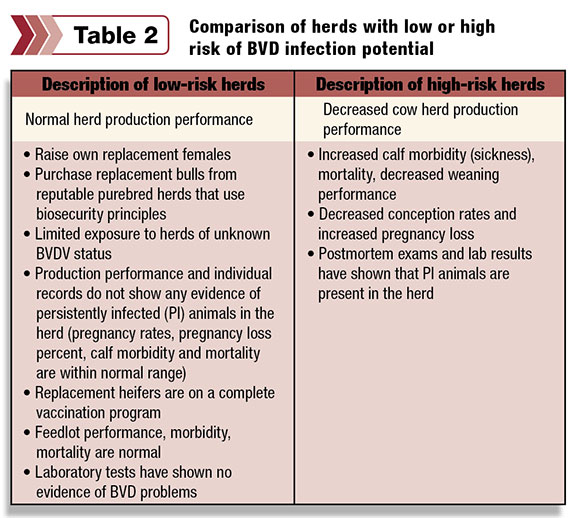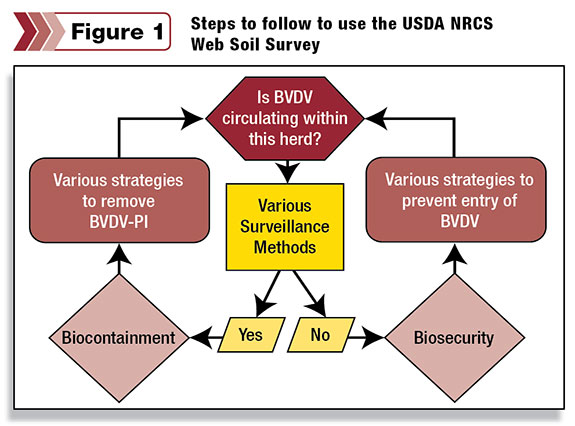The keys for successful control are vaccination, surveillance testing, removal of infected animals and improved biosecurity and awareness.
Background
Bovine viral diarrhea (BVD) causes a variety of clinical outcomes that range from subclinical to severe, include abortion, infertility and immunosuppression, and can result in calf respiratory and enteric diseases, and most dramatically, a fatal mucosal disease.
The disease is maintained by a small population of animals that become persistently infected (PI) with the virus.
These PI animals are the major reservoir of the BVD virus, and calves become infected while in the uterus during early pregnancy.
Such infections can remain throughout the pregnancy, after birth and for the lifetime of the animal. Interestingly, although infection of the fetus results in PI, the mother is only transiently infected (not persistently infected) and becomes immune to the virus within two to three weeks.
PI calves often die prematurely with respiratory or enteric disease – but may live a relatively normal life for several years, all the time shedding large amounts of virus and acting as a reservoir of infection for other cattle.

Table 1 from NAHMS (BVDInfo.org) demonstrates that between 4 and 8 percent of U.S. operations tested had at least one BVD-positive animal, even though infection rates were very low (.04 to .14 percent).
Unpublished data collected over seven years from numerous states has shown that the incidence of BVD has ranged from .21 percent to .55 percent (between two and five infected animals per 1,000 tested).
However, what is concerning is that between 4 and 8 percent of farms and ranches tested had at least one infected animal (Table 1).
PIs are the most significant source of infection of the BVD virus. Removing PIs from the cowherd removes the source of infection and reduces the disease reproduction rate to the point that the virus cannot survive and the disease is controlled.
Despite 60 years of vaccination, BVD infections remain a source of significant economic loss for producers in the U.S.
The perception of a low prevalence of BVD herd infections, the unrestricted sale of PI cattle, lack of economic data, intensive marketing of vaccines, reluctance to accept federal regulations and a “gambler’s” attitude among producers are impediments to implementation of a national systematic BVD control program.
As a rancher, how do you evaluate risk of BVD infection?
The NCBA-BVD working group has recently released a very user-friendly computer program called BVD Consult, which will calculate the cattle producer’s potential for BVD infection in the cowherd. For example, the rancher is asked questions such as:
- Will you quarantine and test all new cattle coming into your breeding herd (including special considerations for pregnant cattle)? – Yes or No
- Can you prevent fenceline and direct contact of your pregnant herd with other cattle? – Yes or No
- Will you use an appropriate BVD vaccination strategy on heifers? – Yes or No
- Have the mature cows in your herd been appropriately vaccinated for BVD? – Yes or No
- Will you apply appropriate surveillance methods? – Yes or No
This program, as well as a wealth of other practical information on this website, can be invaluable to the rancher concerned about the potential for BVD infection in a cowherd.

Table 2 compares cowherds with either high or low risk of BVD infection.
A recent report from Auburn University has dispelled numerous myths and truths about BVD infection. A couple of the myths and correct answers include:
Myth: Multiple low-birthweight calves should raise suspicion of disease due to BVDV.
Confirmed. While calves persistently infected with BVDV can present as normal calves, many times they are small and unthrifty.
In one study, the median live calf birthweights were 37 pounds for PI calves in comparison to 65 pounds for uninfected calves.
Myth: The dam of every PI calf is a PI herself.
Not true. Persistent infection in a calf occurs when the dam is infected with noncytopathic BVD virus prior to approximately 125 to 150 days of gestation.
This can occur following an acute or persistent infection of the dam. Prior research demonstrates that 93 percent of PI calves do not come from a PI dam.
The non-PI cow that experiences an acute infection and subsequently gestates a PI calf throughout pregnancy will not spread BVD after postpartum uterine discharges cease.
This cow will also exhibit the greatest immunity to subsequent disease due to BVD. Thus, culling dams of PI calves without testing to see if the dam herself is PI is clearly poor management in almost all circumstances.

What is the concept of a BVD surveillance program?
The overall strategy for the eradication of the BVD virus from the cowherd can best be described by Figure 1.
The aim of NCBA’s research project is to answer this question: Is the BVD virus circulating in a cowherd?
The focus of this project is to develop a surveillance database to determine infection rates (similar to Table 1) by the use of an ear notch of calves and feeder cattle.
This plan does not have a focus of developing eradication strategies because this needs to be a plan developed by the rancher and his veterinarian.
What is the NCBA-BVD research surveillance plan?
A program that emphasizes the importance of educating the producers of the U.S. cattle industry on proper BVD control. The keys are education, vaccination, testing/removal of PIs and improved biosecurity and awareness.
Why would NCBA be interested in evaluating a surveillance plan?
BVD continues to be the most costly virus to the U.S. cattle population. This virus starts at the farm or ranch and causes decreased reproduction, increased sickness and death loss, and reduced performance.
The main reservoir for the virus is a PI animal that is formed during gestation.
- NCBA has contact with cattlemen all across the country, and this effort has great economic benefit for the industry, as the disease is estimated to cause over one billion dollars in losses.
- NCBA covers all segments of the industry. For the effort to be successful, the cow-calf, stocker and feeder need to be involved. The feeder can assist in getting info back to the ranch and through surveillance data demonstrate areas that need an educational effort.
- Ability to generate a national database of generic testing data that would demonstrate efforts and improvements in control.
This surveillance service is guaranteed to be confidential. The Producer Education Group at NCBA is not interested in where the specific ranch is located.
Our only focus is to determine the rates of infection, to provide educational materials about the disease and its control, and most importantly, to help the rancher start a surveillance program which leads to eradication of BVD or enhanced biosecurity of the farm or ranch.
If you determine that you have an infected animal, the next course of action is between you and your local veterinarian. ![]()
John Paterson is executive director of producer education with the National Cattlemen’s Beef Association. Contact John for more information about participating in this project of surveillance testing.









